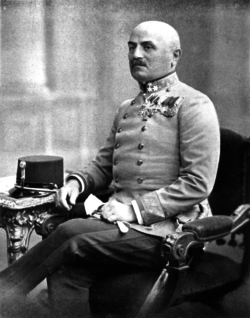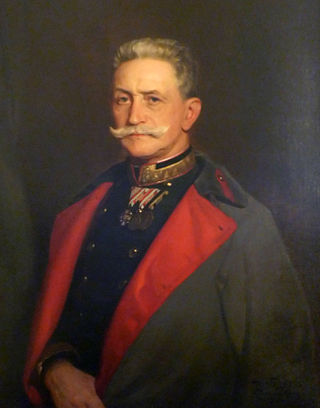
Franz Xaver Josef Conrad von Hötzendorf, sometimes anglicised as Hoetzendorf, was an Austrian general who played a central role in World War I. He served as K.u.k. Feldmarschall and Chief of the General Staff of the military of the Austro-Hungarian Army and Navy from 1906 to 1917. He was in charge during the July Crisis of 1914 that caused World War I.
The 1st Army was a field army-level command in the ground forces of Austria-Hungary during World War I. The army fought in Galicia and Russian Poland in 1914–15 before being briefly dissolved in the summer of 1916. Shortly afterwards, it was reformed and sent to fight in the Romanian Campaign for the next two years. The 1st Army was demobilized in April 1918 due to its heavy losses, following Romania's surrender.

The Battle of Galicia, also known as the Great Battle of Galicia, was a major battle between Russia and Austria-Hungary during the early stages of World War I in 1914. In the course of the battle, the Austro-Hungarian armies were severely defeated and forced out of Galicia, while the Russians captured Lemberg and, for approximately nine months, ruled Eastern Galicia until their defeat at Gorlice and Tarnów.

The Battle of the Vistula River, also known as the Battle of Warsaw, was a major Russian victory against the German Empire and Austria-Hungary on the Eastern Front during the First World War.
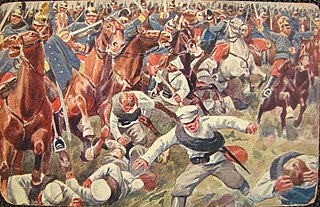
The Battle of Kraśnik started on August 23, 1914, in the province of Galicia and the adjacent areas across the border in the Russian Empire, in northern Austria, and ended two days later. The Austro-Hungarian First Army defeated the Russian Fourth Army. It was the first victory by Austria-Hungary in World War I. As a result, the First Army's commander, General Viktor Dankl, was (briefly) lauded as a national hero for his success. The battle was also the first of a series of engagements between Austria-Hungary and Russia all along the Galicia front.

Viktor Julius Ignaz Ferdinand Graf Dankl von Kraśnik was a highly decorated Austro-Hungarian officer who reached the pinnacle of his service during World War I with promotion to the rare rank of Colonel General (Generaloberst). His successful career met an abrupt end in 1916 due to both his performance on the Italian front and health issues. After the war, he would be a vocal apologist for both his country's war record and the dethroned Habsburg monarchy.

The Military Order of Maria Theresa was the highest military honour of the Habsburg monarchy, Austrian Empire and Austro-Hungarian Empire.
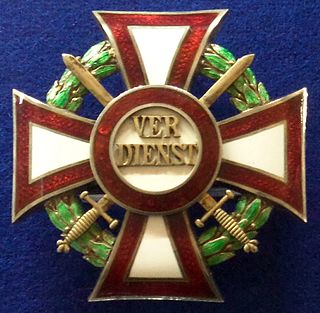
The Military Merit Cross was a decoration of the Empire of Austria and, after the establishment of the Dual Monarchy in 1867, the Empire of Austria-Hungary. It was first established on October 22, 1849 and underwent several revisions to its design and award criteria over the years of its existence. It became obsolete in 1918 with the dissolution of the Austro-Hungarian Empire.

Rudolf Stöger-Steiner Freiherr von Steinstätten was a colonel general in the Austro-Hungarian army and served as the last Imperial Minister for War not only to the Austro-Hungarian Empire but also to the ancient Habsburg monarchy which sat at its head.

Leopold Freiherr von Hauer was a Colonel General in the Austro-Hungarian Army. He participated in the First World War on the Russian front.

Karl Freiherr von Pflanzer-Baltin was an Austro-Hungarian general who was active in World War I.

Karl Christof Friedrich von Gerok was an officer of Württemberg, general of the infantry of the XXIV Reserve Corps during World War I.

The leaders of the Central Powers of World War I were the political or military figures who commanded or supported the Central Powers.

Bernhard Gottfried Max Hugo Eberhard, Graf von Schmettow, usually shortened to Eberhard Graf von Schmettow, was a German general of World War I.

Karl Tersztyánszky von Nádas, officially Károly Tersztyánszky, also alternatively written Tersztyánszky de Nádas was an Austro-Hungarian general who served in World War I.

Johann von Salis-Seewis also known as Johann Ulrich Graf von Salis-Seewis was an Austro-Hungarian military officer during World War I. Austrian Salis-Seewis commanded the Croatian 42nd Honvéd Infantry Division first as part of the unsuccessful Serbian Campaign of 1914 and then on the Carpathian Front. On his return, he became military commander of Vienna before serving as the first military governor of the Military General Governorate of Serbia during the Austro-Hungarian occupation. He later commanded the 92nd Landwehr Infantry Division during the Romanian campaign and headed the Supreme Command in occupied Romania. After the dissolution of the Austro–Hungarian monarchy, following its defeat in the war, Salis-Seewis settled in Croatia where he got involved with the Croatian fascist Ustaše.

Ludwig Goiginger was an Austro-Hungarian Lieutenant Field Marshal who notably served in World War I.
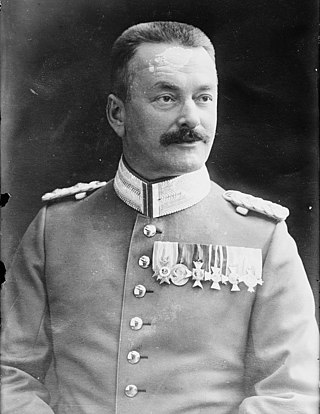
Paul von Kneußl, since 1913 Ritter von Kneußl, was a German general. He was most notable for his service in the Romanian Campaign of World War I.

Karl Křitek was an Austro-Hungarian Army general. He notably commanded several armies during World War I.
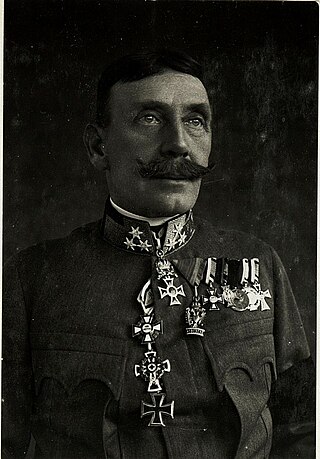
Ludwig Können-Horák von Höhenkampf was an Austrian General of the Infantry who participated in World War I. He was the main Austro-Hungarian commander of the White War as he assumed command over 30 battalions of the war.
